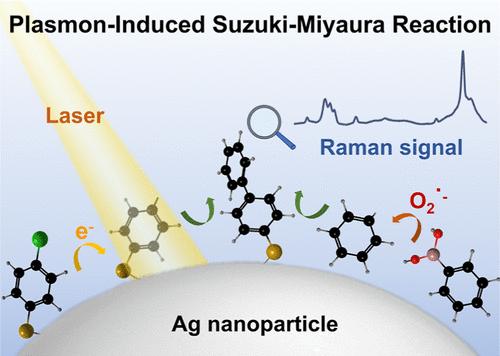通过拉曼光谱揭示银纳米粒子上的等离子体诱导的铃木-宫浦反应
IF 11.3
1区 化学
Q1 CHEMISTRY, PHYSICAL
引用次数: 0
摘要
铃木-宫浦偶联反应是一种合成联苯产品的高效有机方法。然而,该方法传统上依赖于有毒的可溶性有机金属钯催化剂或昂贵的钯纳米粒子,同时需要较高的温度和较长的反应时间,这给我们带来了巨大的挑战。在此,我们展示了一种使用等离子银纳米粒子的无钯方法,该方法可在室温、可见光条件下进行铃木-宫浦偶联反应。利用银的表面增强拉曼散射特性,我们对反应进行了动态自我监测。我们的研究结果表明,这种等离子体诱导的铃木-宫浦偶联反应从根本上说是一种异质反应,涉及自由基之间的偶联,有别于传统的钯基反应。此外,作为耦合的基本前提,C-Cl 和 C-B 键的裂解分别由等离子体热电子和等离子体诱导的活性氧驱动。这些发现不仅为等离子催化剂的设计和调控提供了见解,而且从更广泛的角度加深了对铃木-宫浦反应的理论理解。本文章由计算机程序翻译,如有差异,请以英文原文为准。

Unveiling Plasmon-Induced Suzuki–Miyaura Reactions on Silver Nanoparticles via Raman Spectroscopy
The Suzuki–Miyaura coupling reaction is an efficient organic method for synthesizing biphenyl products. However, its conventional reliance on toxic soluble organometallic palladium catalysts or expensive palladium nanoparticles, along with the need for elevated temperatures and prolonged reaction times, presents a significant challenge. Herein, we demonstrate a palladium-free approach using plasmonic silver nanoparticles that enables the Suzuki–Miyaura coupling reaction to proceed at room temperature under visible light. Utilizing the surface-enhanced Raman scattering characteristics of silver, we conducted dynamic self-monitoring of the reaction. Our findings reveal that this plasmon-induced Suzuki–Miyaura coupling reaction fundamentally operates as a heterogeneous reaction involving coupling between radicals, distinct from conventional palladium-based reactions. Moreover, the cleavage of C–Cl and C–B bonds, fundamental prerequisite to the coupling, is driven by plasmonic hot electrons and plasmon-induced reactive oxygen species, respectively. These findings not only provide insights into the design and regulation of plasmonic catalysts but also enhance theoretical understanding of the Suzuki–Miyaura reaction in a broader context.
求助全文
通过发布文献求助,成功后即可免费获取论文全文。
去求助
来源期刊

ACS Catalysis
CHEMISTRY, PHYSICAL-
CiteScore
20.80
自引率
6.20%
发文量
1253
审稿时长
1.5 months
期刊介绍:
ACS Catalysis is an esteemed journal that publishes original research in the fields of heterogeneous catalysis, molecular catalysis, and biocatalysis. It offers broad coverage across diverse areas such as life sciences, organometallics and synthesis, photochemistry and electrochemistry, drug discovery and synthesis, materials science, environmental protection, polymer discovery and synthesis, and energy and fuels.
The scope of the journal is to showcase innovative work in various aspects of catalysis. This includes new reactions and novel synthetic approaches utilizing known catalysts, the discovery or modification of new catalysts, elucidation of catalytic mechanisms through cutting-edge investigations, practical enhancements of existing processes, as well as conceptual advances in the field. Contributions to ACS Catalysis can encompass both experimental and theoretical research focused on catalytic molecules, macromolecules, and materials that exhibit catalytic turnover.
 求助内容:
求助内容: 应助结果提醒方式:
应助结果提醒方式:


